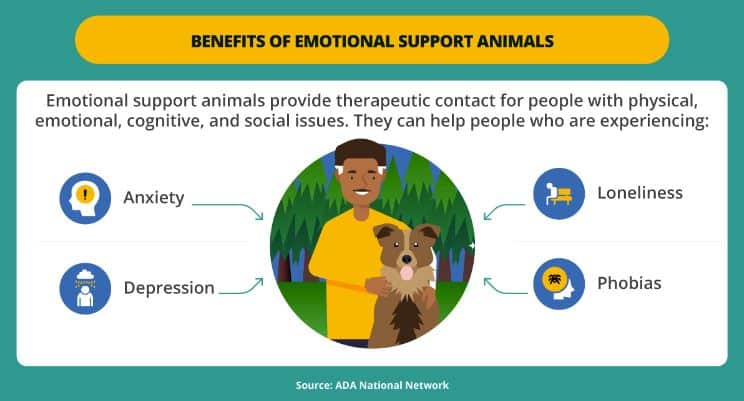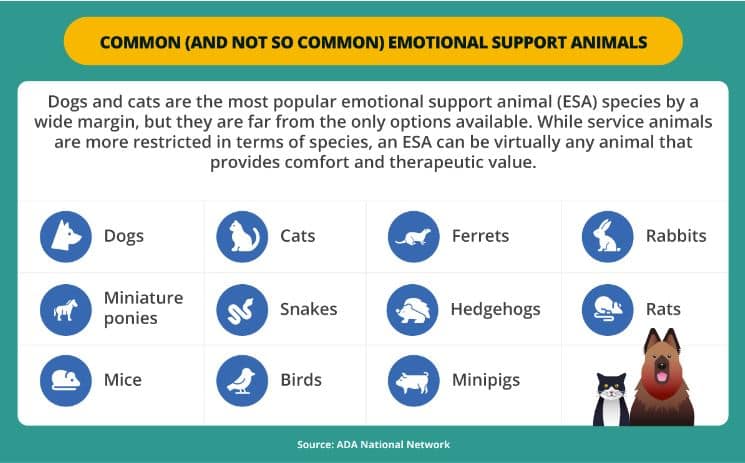
Emotional support animals (ESAs) are pets who offer their owners unique therapeutic benefits. While these ESAs differ from other pets and registered service animals, they can provide significant assistance to people with emotional or mental conditions.
Explore the similarities and differences between a companion and emotional support animal and a service animal. Identify the key benefits of these valued pets, review the common types of support animals, and review the differences between them and service animals. Explore the steps required for a pet to qualify and see how they can improve the workplace and other situations.
Benefits of Companion and Emotional Support Animals
An emotional support animal can provide many therapeutic benefits for individuals seeking comfort, support, companionship, and emotional relief. Medical professionals may offer a letter of recommendation. This letter documents that a licensed medical professional considers an animal to be of therapeutic value to the individual for mental health reasons.
There are many situations in which an ESA can offer value to an individual. Here are some of the most common conditions that companion and emotional support animals can help address:
- Anxiety
- Depression
- Loneliness
- Phobias

In all of these situations, an ESA offers distinct benefits that may or may not be offered by a pet. According to Counseling Today, a publication of the American Counseling Association, many individuals with mental health issues receive positive social interaction benefits from a support animal.
These benefits include more than just feelings of calm and relaxation. An ESA can actually normalize blood pressure and heart rate, reduce pain and stress, and enhance social interactions. Even if an animal hasn’t been professionally trained or licensed, it may help reduce the risks and symptoms of depression and anxiety.
A letter of recommendation from a licensed medical health practitioner may not be required for an individual to enjoy these benefits. It can be helpful, however, to allow individuals to bring their ESAs to work, school, or other situations. These situations are covered under the Americans with Disabilities Act (ADA), which allows for reasonable accommodations for an individual with a disability.
Types of Emotional Support Animals
There’s a reason the common term is emotional support animals, not emotional support dogs. There are many distinct types of emotional support animals that all help to reduce anxiety and improve mental health.
The most important feature of an ESA is that it provides assistance. According to American Humane, an ESA is any companion animal that helps cope with mental health or emotional conditions. These companions provide comfort through services or just with their presence.
Dogs
According to Statista, there are over 89 million dogs in the United States. Approximately 500,000 of those are service dogs and approximately 200,000 are ESAs. Because dogs are the most common types of emotional support animals, they also tend to be more welcomed and accepted in various social situations.
Cats
Can cats be emotional support animals? Cats are, on average, more independent animals that may not seem like a natural choice for an ESA. They are, however, capable of providing this support as long as they provide a calming presence and improve the emotional health of one or more individuals.
Other Animals
Dogs and cats are the most popular ESA species but they are far from the only options available to individuals with a professional recommendation from a mental health practitioner. While service animals are more restricted in terms of species, an ESA can be virtually any animal that provides comfort and therapeutic value. Here are some common animals that can be chosen as ESAs:
- Ferrets
- Rabbits
- Pigs
- Miniature ponies
- Snakes
- Hedgehogs
- Rats
- Mice
- Birds
- Minipigs

Emotional Support vs. Service Animals
There are many misconceptions between emotional support animals and service animals. While an ESA can offer distinct emotional support, these animals may legally qualify as service animals. The areas where an animal is allowed varies depending on these definitions, so it’s important to understand the similarities and differences.
Are Emotional Support Animals Service Animals?
An ESA isn’t defined by species or training. A licensed mental health provider recommends them for emotional and mental health reasons.
A service animal, however, is specifically defined by the ADA. These animals are “individually trained to do work or perform tasks for people with disabilities.” Most service animals are dogs.
Where Can an Emotional Support or Service Animal Go?
ADA defines specific tasks service dogs can perform for individuals. These dogs must go through strict training and be properly licensed in order to qualify. Once qualified, they’re allowed in any government, nonprofit, or business location that allows the public to enter. The service dog must always be fully under the control of the handler.
According to the U.S. Department of Housing and Urban Development (HUD), both ESAs and service animals are considered assistance animals. Individuals with assistance animals are eligible to provide reasonable accommodations in their dwelling. As long as the owner is in control of the ESA, the owner can request to live with the animal in a property with a policy of no pets. The owner can also apply to waive any pet-related fees.
What Airlines Allow Emotional Support Animals?
In December 2020, the U.S. Department of Transportation issued a final rule that removed the requirement for airlines to provide accommodations for individuals with emotional support animals. This means that the individual airline companies can determine whether they will accept ESAs into the cabin.
Unfortunately, virtually every airline has chosen to remove its ESA policy. Some domestic airlines still allow pets on board if they are under 20 pounds. These airlines typically charge a fee and don’t usually have a policy for larger pets. There are a few international airlines that are still accepting ESAs. As of 2021, that list includes:
- Latam Airlines
- Volaris
- Virgin Australia
- Norwegian Air
- China Air
- Singapore Air
- Westjet
Carefully read the requirements for each airline, as the definitions of ESA and the additional requirements vary. Latam Airlines, for example, only recognizes dogs as emotional support animals.
While the airlines that allow emotional support animals are few and mostly operate outside of the United States, all airlines are still required to accommodate service animals. As long as a dog is trained as a psychiatric service dog and remains under the control of the handler, then it will still be allowed on airlines.
Benefits of Emotional Support Animals at Work
Now that you know what airlines allow emotional support animals, consider the benefits of ESAs in other environments. The workplace is another area where an ESA can offer distinct benefits to individuals. Here are some key benefits of workplace emotional support animals:
- Enhances workplace culture: Some companies choose to bring ESAs into the workplace to benefit every worker. Time in the break room or walking the halls with a trained ESA can make a positive impact on company culture and be a welcomed benefit for employees.
- Reduces stress: Employees who are allowed to bring their ESAs to work may experience reduced stress in the office.
- Promotes employee wellness: Just like in other situations, ESAs in the workplace can promote positive feelings, reduce stress, and a sense of calm. Employers and employees must work to ensure ESAs are under control and trained in order to create a safe, productive, and positive workplace.
If an employer is hesitant about allowing an ESA in the workplace, then an employee must submit a request for accommodations under the ADA. As long as this is deemed a reasonable accommodation, the employee must allow the ESA in the workplace as long as it complies with safe handling practices.
Employers who are hesitant may, however, offer other accommodations that provide similar results with fewer potential workplace disruptions. For example, working in a more secluded office or taking more frequent breaks may give the employee similar stress relief. If this is the case, the employer may legally deny an ESA in the workplace.
Who Else Can Benefit From Emotional Support Animals?
All types of emotional support animals can be used in a variety of situations to ease stress, improve mental health, and create a positive culture. With the right policies and approvals, ESAs can be welcomed additions to a number of social situations. Here are a few groups of individuals who may benefit from an ESA:
- Children and teenagers who are at risk of depression, anxiety, or another mental health disorder
- Veterans and active-duty soldiers
- Students of all ages
- Inmates
- Anyone with a psychiatric disorder
There are many programs that allow individuals in these situations to access the mental health support of an ESA. Pups in Prison, for example, is a rehabilitation program that connects inmates with assistance dogs in Australia. Other programs offer time with ESAs to students, soldiers, or other groups of people who may not be able to own and care for an animal due to their situation.
Steps to Qualify for an Emotional Support Animal
The process of qualifying for an emotional support animal isn’t as complex as the process of qualifying for a service animal. Unlike service animals, ESAs don’t have to go through specific training procedures or receive a professional certification. All the types of emotional support animals require you to follow these steps:
Receive an ESA letter certifying you as emotionally disabled. This can be done by a psychiatrist, therapist, psychologist, or other mental health professional.
Review the letter to ensure it contains the following:
- Official letterhead
- Signature of the medical practitioner
- A statement that an ESA is essential to your treatment process
- Date not more than a year old
Submit the letter to an employer, landlord, or another individual as an ADA accommodation, if necessary.
Additional Resources
Explore the following resources to learn more about your rights as an owner of an emotional support animal or service animal:
- Service Dog Certifications: How to Qualify for an Emotional Support Animal
- HR Source: Workplace requirements for ESAs
- Michelson Found Animals, Reducing The Stress Surrounding Emotional Support Animal Requests
- Found Animals.org: Popular types of ESAs
- Federal Register: Up-to-date information on traveling with ESAs
- ADA.gov: Information on your rights as an American with a disability
- HUD.gov: Resources on Fair Housing Act and assistance animals
Sources:
Everything You Need to Know About Emotional Support Animals
Service Animals and Emotional Support Animals | ADA National Network
Service Animal or Emotional Support Animal: What’s the Difference? | ADA National Network
Confirming the benefits of emotional support animals – Counseling Today
Emotional Support Animals: The Basics | Transitions to Adulthood
The Benefits of Emotional Support Animals | ESA Registration
Types of Emotional Support Animals: A Complete Guide
Definition of a Service Dog vs. Emotional Support Animal vs. Therapy Dog
Must Read Service Dog Statistics 2021 –
ADA 2010 Revised Requirements: Service Animals
Assistance Animals | HUD.gov / US Department of Housing and Urban Development (HUD)
Federal Register :: Traveling by Air With Service Animals
Which Airlines Are Still Allowing Emotional Support Animals? – ESA Doctors
Emotional Support Animals & the Workplace
How to Qualify for An Emotional Support Animal – Service Dog Certifications
